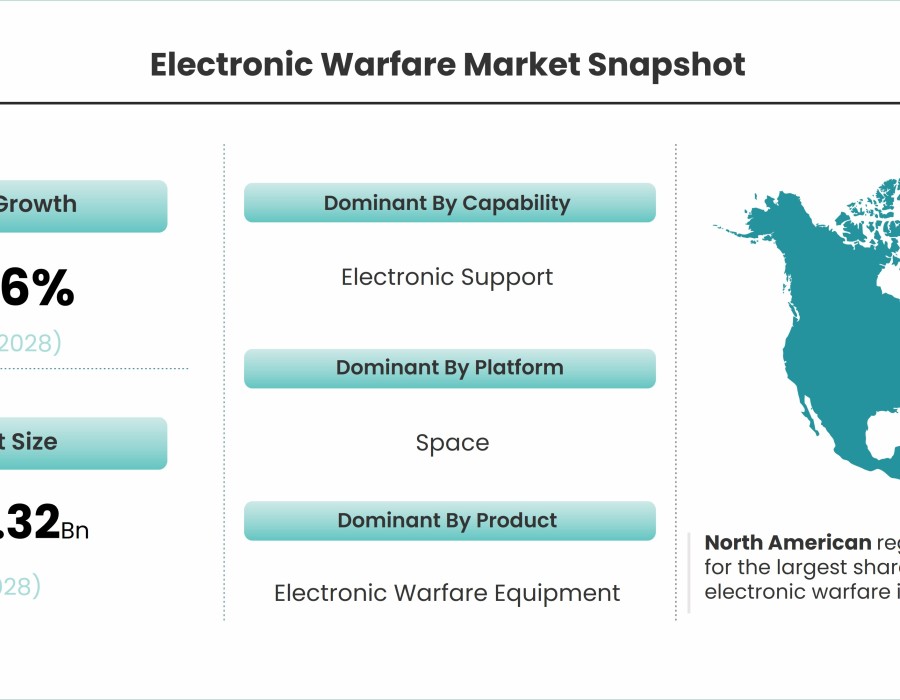According to Stratview Research, the electronic warfare market was estimated at USD 18.44 billion in 2022 and is likely to grow at a CAGR of 4.66% during 2023-2028 to reach USD 24.32 billion in 2028.
In an era where technology is at the forefront of military strategy, electronic warfare (EW) has emerged as a pivotal element in modern defense systems. The rapid development of electronic warfare capabilities is changing the face of warfare, making it essential to understand the fundamental aspects of this growing market. In this article, we'll explore the essentials of electronic warfare, its significance, and its expanding role in contemporary military operations.
The Fundamentals of Electronic Warfare
Electronic warfare encompasses a wide range of technologies and tactics designed to gain control over the electromagnetic spectrum. This includes activities like jamming enemy communications, intercepting signals, disrupting radar systems, and conducting cyber warfare. Electronic warfare isn't just about offensive actions; it's also about defensive measures to ensure friendly forces maintain a tactical advantage.
The Significance of Electronic Warfare
Electronic warfare plays a crucial role in modern military operations for several reasons:
Disrupting Communication: One of the primary functions of electronic warfare is to disrupt an adversary's communication systems. By jamming radio frequencies and blocking enemy signals, it's possible to confuse and hinder the coordination of hostile forces.
Enhancing Stealth: Electronic warfare can enhance the stealth of military assets by reducing their electromagnetic footprint. This is particularly important in making aircraft, ships, and ground vehicles less detectable to radar and other electronic surveillance systems.
Cybersecurity and Cyber Warfare: In an age when information and data are crucial assets, electronic warfare extends into cyberspace. It involves protecting critical infrastructure and launching cyberattacks against adversaries.
Signals Intelligence: EW includes the interception, analysis, and deciphering of enemy signals, providing valuable intelligence for military operations.
Market Dynamics: A Booming Industry
The electronic warfare market is experiencing substantial growth, driven by a range of factors:
Technological Advancements: Ongoing innovations in electronics, artificial intelligence, and software have revolutionized electronic warfare capabilities, making them more potent and versatile.
Global Security Concerns: In an increasingly uncertain world, countries are investing heavily in their defense capabilities, and electronic warfare is a critical component of this investment.
Growing Cyber Threats: The increasing threat of cyberattacks has made electronic warfare a pivotal tool in defending against these digital intrusions.
Multi-Domain Operations: The integration of electronic warfare across various military domains, including land, sea, air, space, and cyberspace, is driving market expansion.
Challenges and Ethical Considerations
While electronic warfare offers substantial advantages, it also raises ethical and strategic challenges:
Ethical Concerns: The use of electronic warfare can have severe consequences, both in terms of collateral damage and violations of international laws and norms.
Security Risks: The reliance on electronic systems exposes vulnerabilities to cyber threats. Ensuring the security of EW systems is a constant concern.
Budget Constraints: As the market expands, the costs associated with electronic warfare technologies can strain defense budgets.
The Future of Electronic Warfare
The future of electronic warfare promises to be even more dynamic and sophisticated. Key trends to watch for include:
AI Integration: The integration of artificial intelligence will enable quicker and more precise responses to threats.
Non-Kinetic EW: Non-kinetic techniques, such as electronic warfare conducted in cyberspace, will continue to gain prominence.
Adaptive EW: Systems that can adapt to the rapidly changing electronic environment will become critical in maintaining the upper hand.
Conclusion
The electronic warfare market is a dynamic and evolving field, crucial to modern defense and security strategies. It shapes the way nations protect their interests, and its continued growth and development have far-reaching implications for the future of global security. As the world becomes increasingly reliant on electronic systems, electronic warfare will remain a critical tool for safeguarding national interests and maintaining military advantage. Understanding this complex market is essential for navigating the complexities of modern conflict and defense in an interconnected world.






Comments